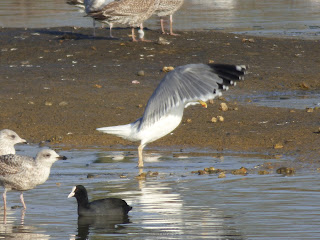I made the most of my day off of school on Tuesday by going to Beddington Farmlands. I did not expect anything too much but I was looking forward to scanning the gulls as always. It was one of those days where there were plenty of gulls about, but there just seemed to be not many 'interesting' ones within them. A regularly seen Caspian Gull was surprisingly the only one about, with no sign of the usual 2nd winter, and an adult Northern Herring Gull was also present on 100 Acre. Overall, the day was quiet. Not much else was happening: the lakes were frozen and that had dramatically reduced the number of wildfowl, plus there was little activity of smaller birds and no larger raptors. But then rather suddenly, Dave Warren shouted, "Zach, this gull has yellow legs!" Instantly I was revived with some excitement that there was actually something decent out there. I quickly got onto Dave's bird and I was pleased to see that the mantle was darker than the surrounding Herring Gulls, but not as dark as a Lesser Black-backed Gull (LBBG). Did we finally have the first Yellow-legged Gull (Larus michahellis) of the year for the Farmlands? Being an adult made it all the more exciting as they are known to be less frequent at Beddington than younger birds, and I saw it as a perfect opportunity to study its different features. Dave and I started to get several hundred pictures of the bird so that we got every angle necessary. I was cautious to call it as a definite adult michahellis at first. I was aware of the potential of a hybrid and also the occurrence of yellow-legged omissus Herring Gulls. However, I was not aware of the frequency of omissus Herring Gulls in the UK but I did presume they were scarcer than michahellis, which I now know is the case. Multiple pics of the bird in question here:
 |
| Dark mantle, clean white head, red orbital ring, and yellow legs |
 |
| For comparison of mantle colour with Herring Gull (left) |
 |
| A quick glimpse of the primary pattern - a black band on p5! |
 |
| A better view of p5 - band nice and broad but broken at shaft |
 |
| From further away, detail of p5 band is lost and looks perfect for michahellis |
 |
| p10 with complete subterminal band separating the small mirror from the white primary tip, no p9 mirror, extensive black on p8, absence of white tongue tips on p6 and 7, and slightly broken broad p5 band - all fine for michahellis |
 |
| Short pale tongue on p10 |
 |
| Interesting black marks on secondaries |
Overall, and after much debate and input from others, I am sticking with my decision to call this a michahellis from the views I had in the field. Reviewing the pictures, I am happy to rule out omissus Herring Gull based on the fact that this bird has both a subterminal band on p10 (mentioned above) and a broad band on p5. It is very likely that omissus would either have no p10 subterminal band, very limited black on p5, or both. As for hybrids, the most likely and therefore the one considered was Herring x LBBG, but as every feature is within variation for a Yellow-legged Gull, the possibility of a hybrid should not be stressed and it would be very hard to prove anyways.










No comments:
Post a Comment